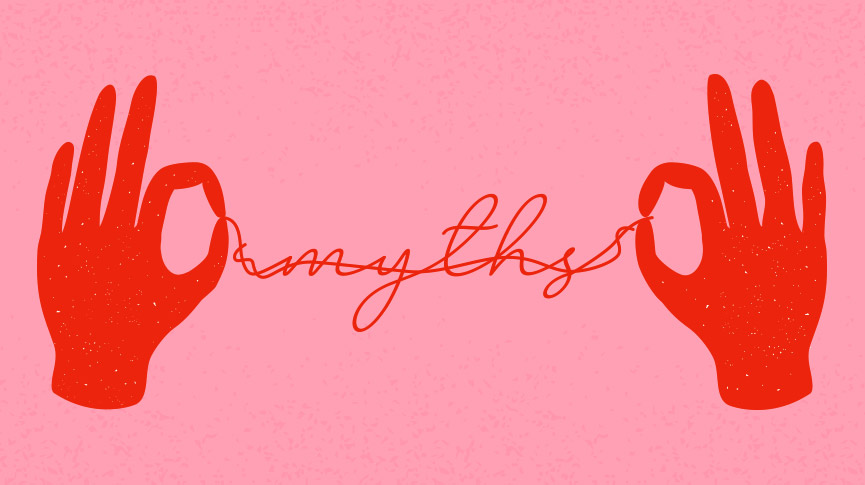Menstrual Cup Myths That You Can Stop Believing Right Now

This article was medically fact-checked by Consultant Obstetrician and Gynaecologist Dr. Shree Datta.
Menstrual cups. Period cups. That Silicone Thing I Stick in My Vag Every Month. Call ’em what you want, babes, but those flexible, reusable cups for managing your menstruation are as trendy as they are amazing.
If you’re still confused, give this article a read and come right back when you’re done. There’s a lot to learn about period cups, and we think you’ll be convinced after a browse through our related articles praising this one-use wonder.
Folks switch to menstrual cups from regular tampons or pads for loads of reasons. Period cups eliminate paper and plastic waste, meaning they’re the best option for the planet. They’re free of harmful chemicals which are often found in bleached pads and tampons. Many users even report reduced cramping and discomfort, and if that’s not a big sign to switch, we don’t know what is. (Oh wait, we do! It’s 8 hours of leak-free wear, unlike that over-soaked tampon that’s threatening to ruin your underwear.)
Like most healthy trends, skeptics are always on hand to toss around rumors that discourage would-be period cup lovers from taking the plunge. That’s why we’re way ahead of you, myth-busting all those nagging questions and assumptions you might have heard from a poorly-informed source (or your best friend who thinks periods are gross, and they’re totally not).
Peep these common myths from the rumor mill, and then watch us bust ’em with sex-pertise.
Myth #1: Periods Are Unsanitary And You Should Avoid Touching Your Own Blood.
Blood doesn’t have the best reputation. We assume blood means pain and injury or disease, and if you’re in a hospital setting, that might be the case. But this couldn’t be further from the truth when it comes to periods.
When you insert or remove a menstrual cup, you’ll get a little period blood on your fingers. It’s unavoidable, but not a reason to freak out. Unless you’ve got a blood-borne disease, like HIV or AIDS, period blood is no different from any other bodily mucous. Of course you should wash your hands after inserting a period cup, or blowing your nose for that matter, but there’s no reason to put period blood into a special gross-out category.
In addition to, well, blood, menstrual fluid is composed of dead cells from inside your uterus. You’ll want to practice the same cleanliness routine you’d use with silicone sex toys: Wash your hands before and after touching your genitals, and wash the period cup with soap and water before and after insertion.
Myth #2: Period Cups Are Too Small To Handle Heavy Periods And They Constantly Leak.
How can one tiny period cup possibly handle what feels like an ocean of blood gushing out of your vagina every month? Because it’s actually not that much blood, we promise.
During an average period, you lose about 80 mL of menstrual blood across five to seven days.
If you’re still not convinced, try going straight to the source: our fans, of course! We asked a devotee of Intimina’s Lily Cup One to tell us the truth behind period cup leaks, and here’s what she had to say about waving buh-bye to leaks.
Myth #3: It’s Not Healthy To Put Plastic In My Vagina For Hours At A Time.
This myth is true in some cases, but you’ve gotta know your plastics before you jump to conclusions.
At Intimina, we only use medical-grade silicone to manufacture our menstrual cups. The name means exactly what it sounds like: this is the same silicone used in doctor’s offices and operating rooms, and it’s been deemed safe by the FDA for long-term wear inside the body.
Though you won’t find anything less than 100% body-safe on Intimina’s product list, there are plenty of companies that use toxic plastics in the creation of sex toys. For example, PVC – a plastic that’s been known to leach harmful chemicals into the body – is definitely a material you want to keep far away from your genitals.
PVC requires the use of phthalates to soften the material, making it pliable and bendable for everything from dildos to vibrators to children’s toys. Phthalates act as endocrine disruptors in the body, and can cause serious reproductive issues when used over long periods of time.
PVC is a common plastic found in lots of home and beauty items, but if you see this plastic in your intimate products, steer clear. It’s not safe for internal use.
Myth #4: I Can’t Have Sex While Wearing A Period Cup.
Now hold on right there, partner! This might be the nastiest rumor yet, and we set out to squash it in a big way with our special pal, the Ziggy Cup.
Traditional periods cups – like the Lily Cup One or even Lily Cup Compact – just aren’t built to handle in-and-out. Whether you’re courting a penis or a sex toy, these cups feature a conical shape and have a small stem that pokes out near the bottom. The cone shape holds the blood, and the stem makes removal easy. ‘Nuff said.
But that’s when the light bulb went on at Intimina HQ: What if we could make a period cup that holds blood just as effectively without restricting penetration? That’s how the Ziggy flat-fit menstrual cup was born.
Ziggy looks like a flexible half-circle instead of a cone, and you squeeze it together and gently push it inside, where a little wiggling will it expand and form to your inner body shape. Ziggy’s double-thick (but still soft) ridge holds strong against any blood that trickles out of your cervix during sex.
Now for the fun part! Insert a toy or a penis, and, well, go about your sexual activity as you would without your crimson flow. Notice anything? Yep, that’s gloriously unrestricted pleasure taking place, and you’ve already forgotten that Ziggy’s even there.
Welcome to your new monthly ritual – sex, without the mess. You’re welcome.
Myth #5: Menstrual Cups Make Fantastic Pet Toys.
Take a wild guess who else in your home is enticed by small, round, squishy things in bright colors – yep, that’d be your cat.
Contrary to kitty’s usual egotistical assumptions, that enticing new toy you bought and conveniently left out on the bathroom sink isn’t, in fact, for him. He might hate you for grabbing it out of his mouth, but we promise he’ll get over it.
Cats stealing menstrual cups is actually a real thing, and although it’s doubtful they’d get hurt from a few crunches into your Lily Cup, we’d recommend keeping your period cup out of your cat or dog’s mouth. At best, a chewed-up cup isn’t exactly the kind of thing we’d tell you to put in your vag, and at worst, your pet is now going to poop out a handful of colorful silicone.
That’s why Intimina’s entire line of menstrual cups come with a carrying case that’ll keep kitties and puppies away from your most prized period possession.
In conclusion, period cups are the best. Period. Just don’t show one to your pets. They might get a little jealous.
Facts checked by:
Dr. Shree Datta
Dr. Shree Datta is a Consultant Obstetrician and Gynaecologist in London, specialising in women’s health including all menstrual problems such as fibroids and endometriosis. Dr. Shree is a keen advocate for patient choice, having written numerous articles and books to promote patient and clinician information. Her vision resonates with INTIMINA, with the common goals of demystifying periods and delivering the best possible care to her patients
Written by:

Colleen Godin is a sexual wellness writer and journalist. She operates a one-woman business at ThePleasureConnection.net, specializing in copywriting, marketing and events for the greater pleasure industry. In her spare time, she enjoys disappearing into the forest, finding herself in a great song, and long drives during spontaneous road trips.




Very nicely written peppered with a light hearted humorous tone & facts to ponder, will forward article to daughter. Thanks 🙂
Does the menstrual cup cause endometriosis because the blood can return to the ovary?
Hi Monique,
please advise your doctor about this matter.
Best regards,